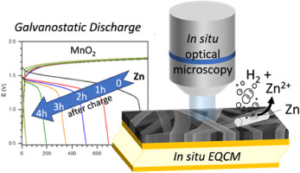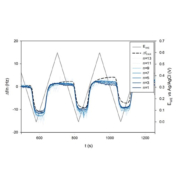Unlocking self-discharge: Unveiling the mysteries of electrode-free Zn-MnO2 batteries with advanced in situ techniques in mild acid aqueous electrolytes
Authors: Arvinder Singh, Lamia Ouassi, Keho Allemang, Jean-François Lemineur, Ozlem Sel, Frédéric Kanoufi, Christel Laberty-Robert
Journal: Journal of Power Sources 2025
Abstract:  We introduce a novel approach to Zinc-MnO2 battery architecture utilizing a 3D network of carbon nanofibers as both current collector and electrode material, promising enhanced performance and longevity for large-scale energy storage. Employing mild aqueous electrolytes, we address the challenge of managing self-discharge, crucial for short-term energy storage. Advanced coupled characterization techniques, including in-situ EQCM (Electrochemical Quartz Crystal Microbalance) and high-resolution optical microscopy, elucidate self-discharge mechanisms across over multiple length scales. Findings reveal that the self-discharge is mainly at the zinc electrode due to concomitant dissolution of Zinc (corrosion) and HER (Hydrogen Evolution Reaction) phenomena. Interestingly, the corrosion current was estimated irrespective of charging protocol and remains consistent, indicating the independence of zinc corrosion kinetics from the length scale. Finally, the morphology of the zinc layer appears to be critical, suggesting that self-discharge is primarily a chemical process. This innovative design strategy offers the potential for high-performance Zinc-MnO2 batteries with extended cycle life to meet the requirements of large-scale energy storage applications.
We introduce a novel approach to Zinc-MnO2 battery architecture utilizing a 3D network of carbon nanofibers as both current collector and electrode material, promising enhanced performance and longevity for large-scale energy storage. Employing mild aqueous electrolytes, we address the challenge of managing self-discharge, crucial for short-term energy storage. Advanced coupled characterization techniques, including in-situ EQCM (Electrochemical Quartz Crystal Microbalance) and high-resolution optical microscopy, elucidate self-discharge mechanisms across over multiple length scales. Findings reveal that the self-discharge is mainly at the zinc electrode due to concomitant dissolution of Zinc (corrosion) and HER (Hydrogen Evolution Reaction) phenomena. Interestingly, the corrosion current was estimated irrespective of charging protocol and remains consistent, indicating the independence of zinc corrosion kinetics from the length scale. Finally, the morphology of the zinc layer appears to be critical, suggesting that self-discharge is primarily a chemical process. This innovative design strategy offers the potential for high-performance Zinc-MnO2 batteries with extended cycle life to meet the requirements of large-scale energy storage applications.



 The abnormal expression of protein tyrosine phosphatase 1B (PTP1B) is highly related to several serious human diseases. Therefore, an accurate PTP1B activity assay is beneficial to the diagnosis and treatment of these diseases. In this study, a dual-mode biosensing platform that enabled the sensitive and accurate assay of PTP1B activity was constructed based on the high-frequency (100 MHz) quartz crystal microbalance (QCM) and dual-signaling electrochemical (EC) ratiometric strategy. Covalent–organic framework@gold nanoparticles@ferrocene@single-strand DNA (COF@Au@Fc-S0) was introduced onto the QCM Au chip via the chelation between Zr4+ and phosphate groups (phosphate group of the phosphopeptide (P-peptide) on the QCM Au chip and the phosphate group of thiol-labeled single-stranded DNA (S0) on COF@Au@Fc-S0) and used as a signal reporter. When PTP1B was present, the dephosphorylation of the P-peptide led to the release of COF@Au@Fc-S0 from the QCM Au chip, resulting in an increase in the frequency of the QCM. Meanwhile, the released COF@Au@Fc-S0 hybridized with thiol/methylene blue (MB)-labeled hairpin DNA (S1-MB) on the Au NPs-modified indium–tin oxide (ITO) electrode. This caused MB to be far away from the electrode surface and Fc to be close to the electrode, leading to a decrease in the oxidation peak current of MB and an increase in the oxidation peak current of Fc. Thus, PTP1B-induced dephosphorylation of the P-peptide was monitored in real time by QCM, and PTP1B activity was detected sensitively and reliably using this innovative QCM-EC dual-mode sensing platform with an ultralow detection limit. This platform is anticipated to serve as a robust tool for the analysis of protein phosphatase activity and the discovery of drugs targeting protein phosphatase.
The abnormal expression of protein tyrosine phosphatase 1B (PTP1B) is highly related to several serious human diseases. Therefore, an accurate PTP1B activity assay is beneficial to the diagnosis and treatment of these diseases. In this study, a dual-mode biosensing platform that enabled the sensitive and accurate assay of PTP1B activity was constructed based on the high-frequency (100 MHz) quartz crystal microbalance (QCM) and dual-signaling electrochemical (EC) ratiometric strategy. Covalent–organic framework@gold nanoparticles@ferrocene@single-strand DNA (COF@Au@Fc-S0) was introduced onto the QCM Au chip via the chelation between Zr4+ and phosphate groups (phosphate group of the phosphopeptide (P-peptide) on the QCM Au chip and the phosphate group of thiol-labeled single-stranded DNA (S0) on COF@Au@Fc-S0) and used as a signal reporter. When PTP1B was present, the dephosphorylation of the P-peptide led to the release of COF@Au@Fc-S0 from the QCM Au chip, resulting in an increase in the frequency of the QCM. Meanwhile, the released COF@Au@Fc-S0 hybridized with thiol/methylene blue (MB)-labeled hairpin DNA (S1-MB) on the Au NPs-modified indium–tin oxide (ITO) electrode. This caused MB to be far away from the electrode surface and Fc to be close to the electrode, leading to a decrease in the oxidation peak current of MB and an increase in the oxidation peak current of Fc. Thus, PTP1B-induced dephosphorylation of the P-peptide was monitored in real time by QCM, and PTP1B activity was detected sensitively and reliably using this innovative QCM-EC dual-mode sensing platform with an ultralow detection limit. This platform is anticipated to serve as a robust tool for the analysis of protein phosphatase activity and the discovery of drugs targeting protein phosphatase.

